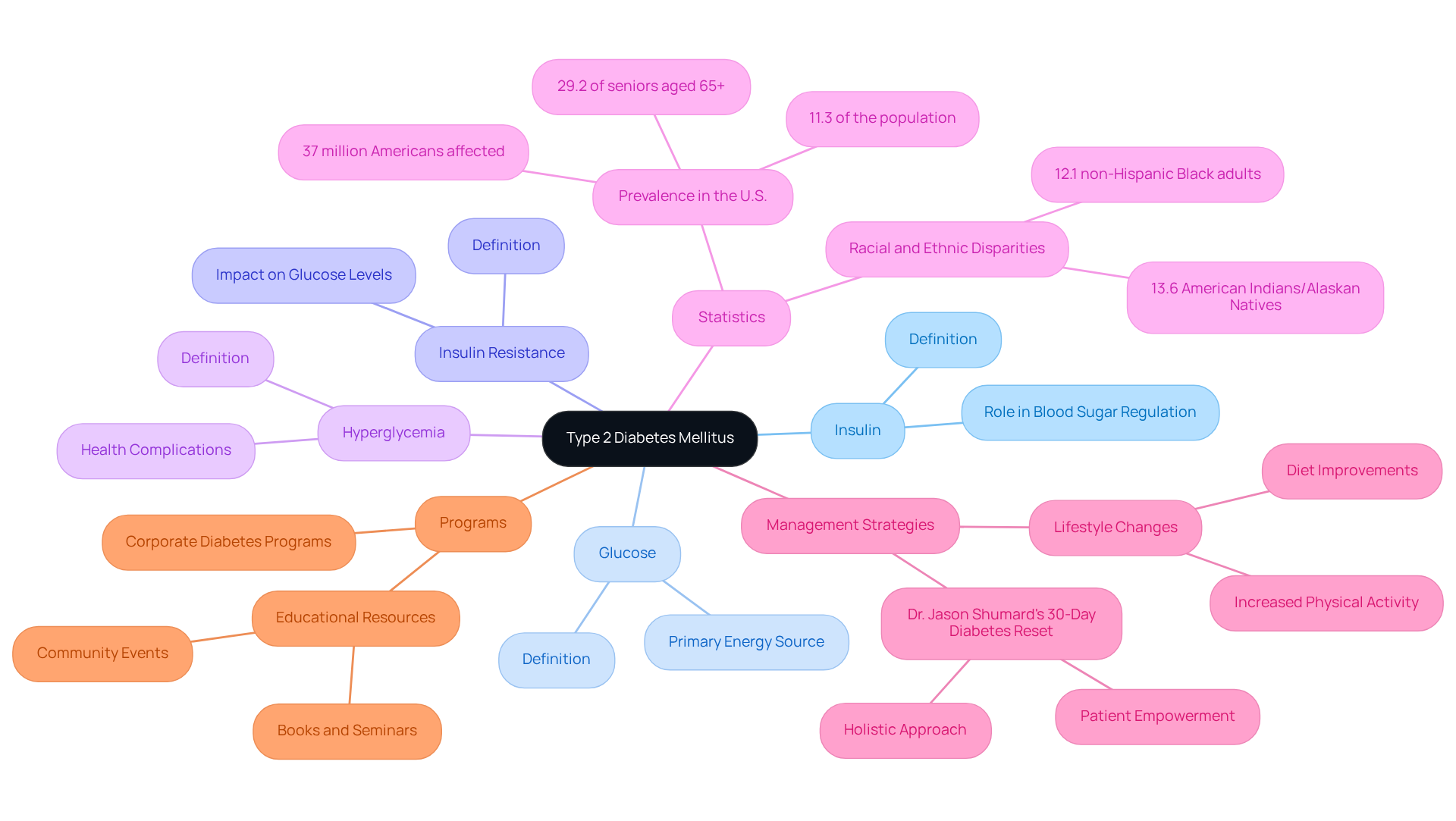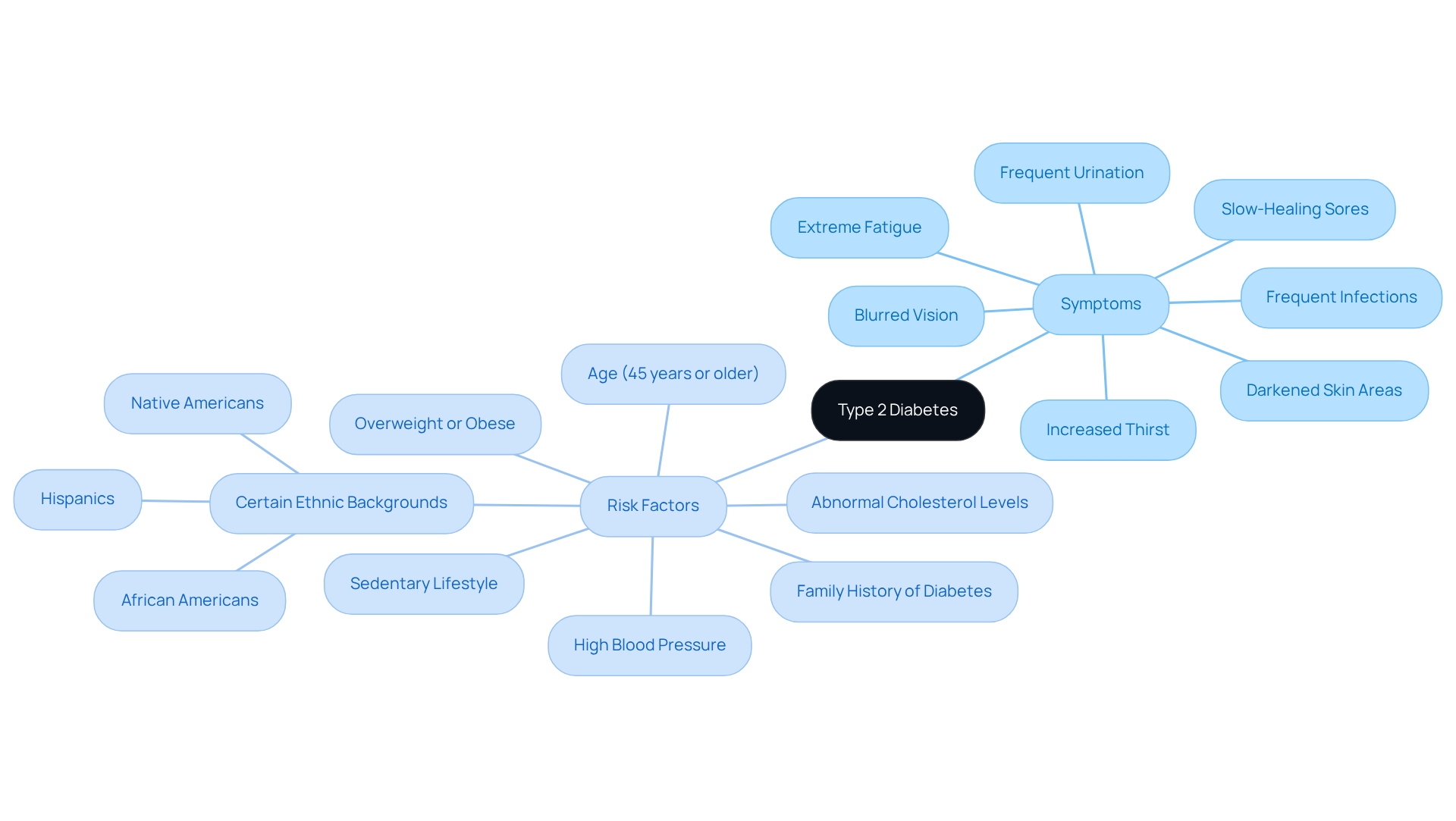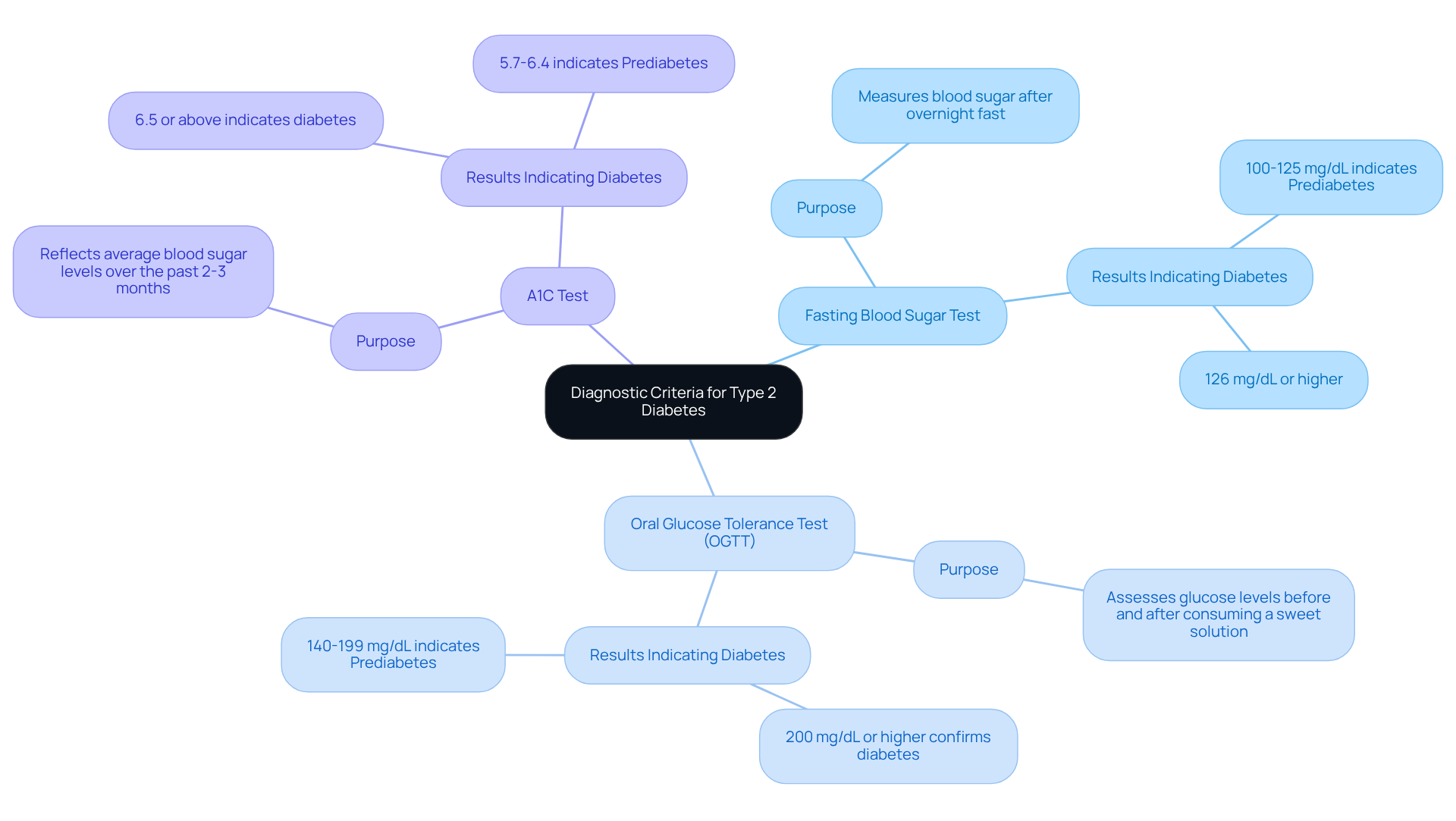Overview
This article centers on mastering Type 2 Diabetes Mellitus by exploring its symptoms, diagnosis, and management strategies. It’s important to recognize that living with diabetes can be challenging, and many individuals experience a range of emotions in their journey. However, effective management through lifestyle changes, education, and personalized care can significantly improve health outcomes. Patient testimonials and successful programs, such as Dr. Jason Shumard’s 30-Day Diabetes Reset, demonstrate this potential for positive change.
Have you ever wondered how small changes can lead to significant improvements in your health? By embracing a supportive community and making informed choices, you can take control of your diabetes. The experiences shared by others highlight the power of personalized care, which not only addresses medical needs but also nurtures emotional well-being.
As you consider your own path, remember that you are not alone in this journey. Many patients find that with the right support, they can achieve remarkable results. The 30-Day Diabetes Reset program is designed to guide you through this process, offering practical strategies and encouragement every step of the way.
In summary, understanding Type 2 Diabetes Mellitus is the first step toward mastery. By focusing on compassionate care and effective management strategies, you can improve your health and enhance your quality of life. Together, let’s embark on this journey toward a healthier future.
Introduction
Understanding diabetes type 2 mellitus is essential in a world where its prevalence continues to rise, affecting millions and posing significant health challenges. It’s important to recognize that this condition not only impacts physical health but also deeply affects emotional well-being. This article delves into the critical aspects of diabetes type 2, exploring its symptoms and risk factors while offering effective management strategies that can empower individuals to reclaim their health. Given the alarming statistics, many patients find themselves overwhelmed by the complexities of navigating this chronic illness.
So, how can we effectively identify and address the multifaceted nature of diabetes type 2 to foster a healthier future? Together, we can explore these challenges and find a path forward.
Define Type 2 Diabetes Mellitus: Key Concepts and Terminology
Diabetes type 2 mellitus is a long-lasting condition that can feel overwhelming, as it marks the body’s diminished capacity to process glucose. Unlike Type 1 diabetes, where insulin production is absent, diabetes type 2 mellitus arises when the body develops insulin resistance or fails to produce sufficient insulin. It’s important to understand some key concepts:
- Insulin: A hormone crucial for regulating blood sugar levels, allowing cells to utilize glucose for energy.
- Glucose: A simple carbohydrate that serves as a primary energy source for the body.
- Insulin Resistance: A condition in which the body’s cells become less responsive to insulin, resulting in increased glucose levels.
- Hyperglycemia: A state of elevated blood sugar that can result in severe health complications if not properly managed.
Recent statistics reveal that around 37 million Americans, or 11.3% of the population, are living with this condition, with diabetes type 2 mellitus accounting for 90-95% of these instances. The prevalence of diabetes type 2 mellitus is particularly concerning among older adults, with 29.2% of seniors aged 65 and older affected. Additionally, racial and ethnic inequalities exist, with 13.6% of American Indians/Alaskan Natives and 12.1% of non-Hispanic Black adults identified with the condition. Grasping these concepts and figures is crucial, as they lay the groundwork for understanding how lifestyle changes can greatly affect the management of this condition and possible reversal approaches.
Many patients find that addressing insulin resistance is essential in managing diabetes type 2 mellitus. Effective management through lifestyle changes—such as improved diet and increased physical activity—can lead to significant health improvements. For instance, in San Marcos, CA, adopting an outdoor lifestyle by utilizing local parks and trails for regular exercise can enhance insulin sensitivity and regulate weight, both of which are vital for managing diabetes type 2 mellitus. It’s noteworthy that 38% of Americans with diabetes type 2 mellitus are physically inactive, highlighting the necessity for enhanced physical activity as an integral part of management strategies.
Dr. Jason Shumard’s 30-Day Diabetes Reset program has shown promising results in empowering patients to reclaim their health by addressing the underlying causes of their condition. Participants share transformative outcomes, emphasizing the importance of education and personalized care in effectively managing diabetes. Furthermore, the economic impact of this condition is substantial, with the total estimated cost of diagnosed cases in the U.S. in 2022 being $412.9 billion. This underscores the importance of effective treatment strategies to alleviate the financial burden of the disease. Dr. Jason Shumard focuses on reversing diabetes type 2 mellitus through functional medicine, offering a holistic approach that prioritizes patient education and empowerment.
Identify Symptoms and Risk Factors of Type 2 Diabetes
Symptoms of diabetes type 2 mellitus can often be subtle, yet they play a crucial role in early detection and management. Common symptoms include:
- Increased thirst and frequent urination
- Extreme fatigue
- Blurred vision
- Slow-healing sores or frequent infections
- Areas of darkened skin, typically found in the armpits and neck
Understanding these symptoms is vital, as they can significantly impact daily life and overall health. In fact, this condition is the leading cause of new instances of blindness among adults aged 18 to 64. It’s important to recognize that early intervention can make a significant difference. One patient shared, “I didn’t realize how serious my symptoms were until I spoke with Dr. Shumard. It changed my perspective on my health completely.” This highlights the necessity for enhanced awareness and education regarding diabetes type 2 mellitus.
Risk factors for developing Type 2 Diabetes are multifaceted and include:
- Being overweight or obese
- Sedentary lifestyle
- Family history of diabetes
- Age (45 years or older)
- High blood pressure or abnormal cholesterol levels
Many patients find that recognizing these risk factors empowers them to take proactive steps in managing their health. Recent studies have identified additional risk factors, such as certain ethnic backgrounds, which show higher prevalence rates among groups like African Americans, Hispanics, and Native Americans. Healthcare professionals emphasize that understanding these factors can be a crucial part of your health journey.
Patient testimonials reveal that many individuals were unaware of their symptoms until they sought medical advice. Another patient noted, “After joining Dr. Shumard’s program, I lost 55 lbs and my A1C improved significantly. I feel so much better now!” By understanding both the symptoms and risk factors of diabetes type 2 mellitus, individuals can better navigate their health journeys and seek timely medical intervention when necessary. Furthermore, the comprehensive approaches utilized at the Integrative Wellness Center—such as tailored nutrition and lifestyle modifications—are essential in efficiently managing diabetes type 2 mellitus.
Explore Diagnostic Criteria and Testing for Type 2 Diabetes
Understanding the diagnosis of diabetes type 2 mellitus can feel overwhelming, but it’s important to recognize that you are not alone in this journey. Several key tests play a crucial role in assessing blood sugar levels, each serving a distinct purpose:
- Fasting Blood Sugar Test: This test measures your blood sugar after an overnight fast. A result of 126 mg/dL or higher usually signifies a blood sugar condition, highlighting the importance of fasting for accurate results.
- Oral Glucose Tolerance Test (OGTT): This test assesses glucose levels before and two hours after consuming a sweet solution. A reading of 200 mg/dL or higher confirms the condition, making it an essential tool for diagnosis.
- A1C Test: This test reflects your average blood sugar levels over the past 2-3 months. An A1C of 6.5% or above indicates a condition, providing a broader perspective on your glucose management over time.
Many patients find that comprehending these diagnostic techniques is vital for their health. Regular monitoring plays a significant role in effectively managing diabetes type 2 mellitus. With approximately 90% of cases classified as diabetes type 2 mellitus, awareness of these criteria can empower you to take proactive steps in your health journey. Recent updates to diagnostic criteria emphasize the importance of these tests, ensuring timely and accurate diagnoses. By acknowledging the significance of fasting glucose assessments and other techniques, you can manage your condition more effectively and enhance your overall health outcomes.
In addition to understanding diagnostic criteria, it’s essential to employ effective techniques for monitoring your progress and setting achievable goals. Tools like fitness applications and journals can help you track daily activities and sugar levels, encouraging responsibility and motivation. Have you considered setting SMART goals—specific, measurable, attainable, relevant, and time-bound? For instance, aiming to achieve a certain number of steps daily or gradually increasing your exercise duration can lead to improved health outcomes.
Dr. Jason Shumard emphasizes that the Integrative Wellness Center offers an innovative 30-Day Reset program designed to equip you with the essential tools and knowledge to manage your condition effectively. Self-monitoring of blood glucose is vital for effective management of diabetes type 2 mellitus, reinforcing the importance of these diagnostic tests. Remember, you are taking a significant step towards better health by engaging with these resources.
Conclusion
Diabetes type 2 mellitus represents a significant health challenge that many individuals face. It’s essential to understand its symptoms, risk factors, diagnosis, and management strategies. This condition, characterized by insulin resistance and elevated blood sugar levels, affects millions and can lead to serious health complications if not properly managed. It’s important to recognize that early detection and lifestyle modifications can greatly improve health outcomes and even reverse the condition.
Have you noticed symptoms like increased thirst, fatigue, or blurred vision? These can signal the onset of diabetes type 2 mellitus. Understanding the risk factors—such as obesity, a sedentary lifestyle, and family history—empowers you to take proactive steps toward prevention and management. Diagnostic criteria, including fasting blood sugar tests and A1C levels, are vital tools in identifying the condition, highlighting the need for regular monitoring and responsible health management.
Ultimately, managing diabetes type 2 mellitus is not just about addressing the condition itself but also about embracing a healthier lifestyle. Many patients find that making informed decisions can lead to significant improvements. Individuals are encouraged to seek education, utilize available resources, and engage in programs like Dr. Jason Shumard’s 30-Day Diabetes Reset to reclaim their health. By prioritizing physical activity and making thoughtful nutritional choices, you can enhance insulin sensitivity and improve your overall well-being.
Taking these steps benefits not only your personal health but also contributes to a broader public health strategy aimed at reducing the prevalence and impact of diabetes type 2 mellitus in communities across the nation. Remember, you are not alone in this journey; support and resources are available to help you every step of the way.
Frequently Asked Questions
What is Type 2 Diabetes Mellitus?
Type 2 Diabetes Mellitus is a long-lasting condition characterized by the body’s diminished capacity to process glucose, resulting from insulin resistance or insufficient insulin production.
How does Type 2 Diabetes differ from Type 1 Diabetes?
Unlike Type 1 Diabetes, where there is no insulin production, Type 2 Diabetes occurs when the body develops insulin resistance or fails to produce enough insulin.
What are some key terms associated with Type 2 Diabetes Mellitus?
Key terms include: – Insulin: A hormone that regulates blood sugar levels. – Glucose: A simple carbohydrate that serves as a primary energy source. – Insulin Resistance: A condition where cells become less responsive to insulin, leading to higher glucose levels. – Hyperglycemia: Elevated blood sugar levels that can cause serious health complications if not managed properly.
What is the prevalence of Type 2 Diabetes in the United States?
Approximately 37 million Americans, or 11.3% of the population, have Type 2 Diabetes, which accounts for 90-95% of all diabetes cases. It is particularly prevalent among older adults, affecting 29.2% of seniors aged 65 and older.
Are there racial and ethnic disparities in the prevalence of Type 2 Diabetes?
Yes, there are disparities, with 13.6% of American Indians/Alaskan Natives and 12.1% of non-Hispanic Black adults diagnosed with Type 2 Diabetes.
What lifestyle changes can help manage Type 2 Diabetes Mellitus?
Effective management often involves lifestyle changes such as improved diet and increased physical activity, which can enhance insulin sensitivity and help regulate weight.
What is Dr. Jason Shumard’s 30-Day Diabetes Reset program?
Dr. Jason Shumard’s 30-Day Diabetes Reset program focuses on empowering patients to reclaim their health by addressing the underlying causes of diabetes, leading to transformative outcomes through education and personalized care.
What is the economic impact of Type 2 Diabetes Mellitus in the U.S.?
The total estimated cost of diagnosed cases of Type 2 Diabetes in the U.S. in 2022 was $412.9 billion, highlighting the importance of effective treatment strategies to reduce the financial burden of the disease.


